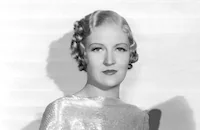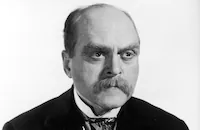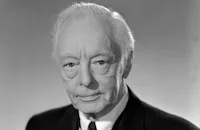First Lady

Brief Synopsis
Cast & Crew
Stanley Logan
Kay Francis
Preston Foster
Anita Louise
Walter Connolly
Verree Teasdale
Film Details
Technical Specs

Synopsis
Lucy Chase Wayne, the granddaughter of a former United States president and the wife of Secretary of State Stephen Wayne, is actively involved in Washington society. Her chief rival in social affairs is Irene Hibbard, the wife of bumbling Supreme Court Justice, Carter Hibbard. Lucy has never forgiven Irene for stealing her cook. They start a battle over the favors of Gordon Keane, a young senator from the West. Gordon has just made a speech, written mainly by Lucy, who hopes he will side politically with Stephen. This irks Irene, who wants Gordon to attend her parties. Meanwhile, Gordon has fallen in love with Emmy Page, Stephen's niece. When Lavinia Mae Creevey, the president of a women's organization, arrives in Washington looking for a presidential candidate to support, Lucy decides to use Lavinia's quest to distract Irene from her pursuit of Gordon. Lucy encourages Lavinia to back Carter as a presidential candidate. Then Ellsworth Ganning, publisher of a chain of newspapers, takes up Carter's cause and it begins to look as if Carter may have a chance to win the nomination. This threatens Lucy's plans to advance Stephen as the nominee. Lucy learns that Irene's ex-husband is in town and she invites him to a party in Carter's honor, because she knows that under the laws of his own country, he is not divorced, which makes Irene a bigamist. To prevent scandal, Carter withdraws from the race, making Stephen the nominee. Gordon becomes engaged to Emmy and Lucy's position at the head of Washington society is secure.

Director
Stanley Logan
Cast

Kay Francis

Preston Foster

Anita Louise

Walter Connolly

Verree Teasdale

Victor Jory

Marjorie Rambeau

Marjorie Gateson

Louise Fazenda

Henry O'neill

Grant Mitchell
Eric Stanley
Lucile Gleason

Sara Haden

Harry Davenport

Gregory Gaye
Olaf Hytten
Crew

Film Details
Technical Specs

Articles
First Lady
Reviewers did, however, praise the work of two other cast members, most notably Verree Teasdale as the rival, an ambitious, backstabbing power-player whose past becomes her undoing. Frank S. Nugent of the New York Times said, "Miss Teasdale, on the other hand, lets [her lines] rip out and curl about her opponent's ears, and rarely bothers to wait for the welts to rise." Teasdale could often be counted on to bring some zing to her roles as society wives, "other women," and second leads in comedies, but her career was curtailed by her marriage to actor Adolphe Menjou and his frequent illnesses. She made her last film in 1941, and the two of them had a popular radio show for a time in the 1940s and 50s. After his death in 1964, she became a clothes designer.
Acting honors also went to Walter Connolly as the bumbling Supreme Court Justice and potential presidential candidate. The 50-year-old Connolly was already an old hand at sharp, funny dialogue, having appeared in such memorable comedies as It Happened One Night (1934), Twentieth Century (1934), and Nothing Sacred (1937). Connolly's talents continued to be in demand for 12 more films over the next two years until his death of a stroke in 1940.
The idea for the story of First Lady originated with Dayton, daughter of a newspaper publisher and an accomplished magazine writer since the early 1920s, whose specialty was politics. She patterned the lead role on one of Washington's most powerful women, Alice Roosevelt Longworth, daughter of President Theodore Roosevelt and wife of Speaker of the House Nicholas Longworth. Because Dayton had never written a play, her agent hooked her up with the most successful playwright of his time, George S. Kaufman, creator of such critical and commercial hits as You Can't Take It with You, Stage Door, Dinner at Eight, and the Marx Brothers stage successes, Animal Crackers and The Cocoanuts. Kaufman liked her idea and agreed to collaborate, but Dayton soon found him to be the "travelingest" co-writer, taking large chunks of time off to go work on other projects. He was also a frequently gloomy presence when they were working together, always sure that this play would not come together and dismissing any compliments and positive feedback about it as irrational and unfounded. The final result, which ran on Broadway from November 1935 to June 1936, turned out to be a sparkling political comedy about the women who pull the strings in the country's highest seats of power, but Dayton and Kaufman never worked together again. In fact, she wrote only one other play, which opened and closed very quickly in 1938.
With the number of his plays that were translated into hit movies, it would have been logical for Kaufman to have had a hugely successful Hollywood career, but he disliked the industry and the way writers were treated by studio bosses. His only film credits (not including the movies based on his own plays) were the first draft screenplay of Roman Scandals (1933), a screenplay he co-wrote with Robert Sherwood (he received only co-story credit after quitting over a dispute with star Eddie Cantor); the Marx Brothers' first MGM movie A Night at the Opera (1935), co-scripted with Morrie Ryskind; and another political comedy, The Senator Was Indiscreet (1947), which he directed from a script by his old friend Charles MacArthur.
Kaufman's trademark wit and keen ear for dialogue are evident throughout First Lady, but it is Dayton, most likely, who deserves the credit the film has received for its portrayal of strong, capable women. In a footnote in her book A Woman's View (Knopf, 1993), Jeanine Basinger notes how men are relatively unimportant to stories such as this, dominated by great women stars. "In First Lady, it is a given that if your best friend steals your cook, she has done you extreme damage; you can't easily replace a good cook in Washington, D.C., and your next party may be ruined by soggy canapés. On the other hand, if your best friend steals your husband, you can easily get another one, and where's the loss? It's not tangible, meaning it won't show up on your dinner table."
The box office failure of First Lady did not bode well for Francis. Whether she knew it or not at the time, the woman who was once Warner's top actress was on her way down at the studio. Bette Davis had won an Oscar® the year before for her work in Dangerous (1935) and turned out four hit pictures the year of First Lady's release, including a strong performance in Marked Woman (1937). It signaled her ascendance to "Queen of the Lot" and within two years, Francis was gone from the studio and playing second fiddle to bigger stars in mostly forgettable films.
Director: Stanley Logan
Producer: Hal B. Wallis
Screenplay: Rowland Leigh, based on the play by George S. Kaufman and Katharine Dayton
Cinematography: Sidney Hickox
Editing: Ralph Dawson
Art Direction: Max Parker
Original Music: Max Steiner
Cast: Kay Francis (Lucy Chase Wayne), Preston Foster (Stephen Wayne), Anita Louise (Emmy Page), Walter Connolly (Carter Hibbard), Verree Teasdale (Irene Hibbard), Victor Jory (Se. Gordon Keane).
BW-83m. Closed captioning.
by Rob Nixon















